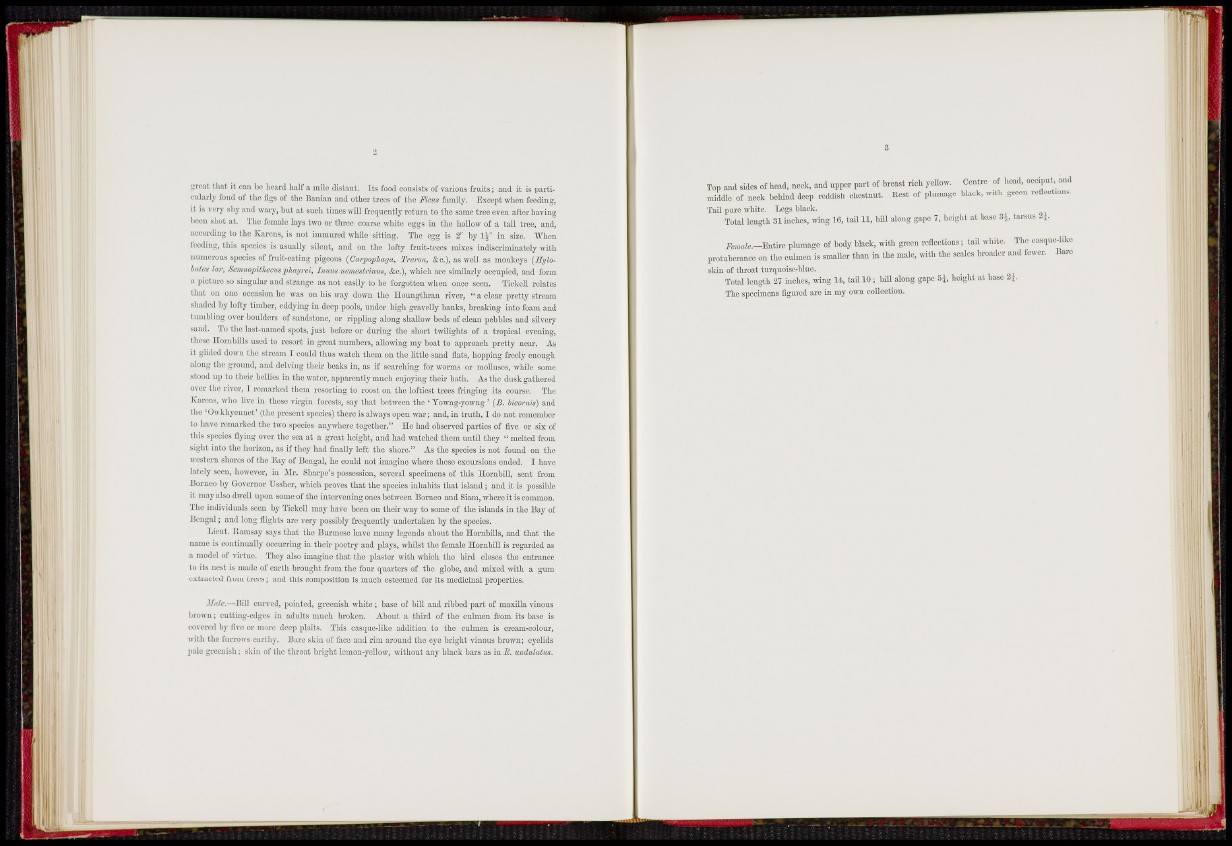
^n-cat that it can be hoard half a mile distant. Its food consists of various fruits; aud it is particularly
fond of tho ñgs of the Banian and other trees of the Fious family. Exccpt when feeding,
it IS vM-y sliy and wary, but at such times \vill frequently return to the same tree even after having
boon shot at. The female lays two or three coarse white eggs in the hollow of a tall tree, and,
according to the Karens, is not immured while sitting. The egg is 2" by in size. "Wbon
flooding, this species is usually silcut, and on the lofty fruit-trees mixes indiscriminately with
numerous species of fruit-eating pigeons {Carpopha<ja, Treron, &c.), as well as monkeys {Ilylobales
lar, Senmo]}ithe<MS phayrei, Inuus nemestrims, &c.), which are similai-ly occupied, and form
a picture so singular and strange as not easily to be forgotten when once seen. Tickell relates
that oil one occasion ho was on his way down the Iloungthran river, "a clear pretty stream
shaded l>y lofty timber, eddying in deep pools, under high gravelly banks, breaking into foam and
tumbling over boulders of sandstone, or rippling along shallow beds of clean pebbles and silvery
sand. To the last-named spots, just before or during tho short twüights of a tropical evening,
those llonibills used to resort ia great numbers, allowing my boat to approach pretty near. As
it glided down the stream I could thus watch them on the little sand fiats, hopping freely enough
along tho ground, and delving tluúr beaks in, as if searching for worms or moUuscs, while some
stood up to their bollios in the water, apparently much enjoying their bath. As the dusk gathered
over the river, 1 remarked them resorting to roost on the loftiest trees fringing its course. The
Karens, M-ho live in these virgin forests, say that between the ' Yowng-yowng ' (£. bicornis) and
the 'Owkhyennet' (the present species) there is always open wai-; and, in truth, I do not remember
to have remarked the two species anywhere together." He had observed pai-tics of five or six of
this species flying over tho sea at a great height, and had watchcd them until they " melted from
sight into the horizon, as if they had finally left the shore." As the species is not found on the
western shores of the Bay of Bengal, he could not imagine where theso excursions ended. I have
lately seen, however, m ilr. Shivrpe's possession, several specimens of this Uornbill, sent from
Borneo by Governor Ussher, which proves that the species inhabits that island; and it is possible
it may also dwell upon some of the intervening ones between Borneo and Siam, where it is common.
The individuals seen by Tickell may have been on theii- way to some of the islands in the Bay of
Bengal j and long flights are very possibly frequently undertaken by tho species.
Lieut. Ramsay says that the Bm-mese have many legends about the Hornbills, and that the
name is continuafly occuri-hag in their poetry and plays, whilst the female IlornbiU is regarded as
a model of ^-irtuc. They also imagine tliat the plaster with which the bird closes the entrance
to its nest is made of earth brought from the four quarters of the globe, and mixed with a gum
extracted from trees; and this composition is much esteemed for its medicinal properties.
2lalc.—Bill curved, pointed, greenish white; base of bül and ribbed part of maxilla vinous
brown; cutting-edges in adults much broken. About a third of the culmen from its base is
covered by ilvc or more deep plaits. This casque-like addition to the culmen is cream-colour,
with the furrows earthy. Bare skia of flico and rim around the eye bright vinous brown; eyelids
l)ale greenish; skin of the throat bright lemon-yellow, without any black bars as in B. tcndalaius.
Top and Sid» of h»d, neck, and upper part of bro»t rich yonmv. Coite ot licad, occiput aud
middle of ncck behind deep reddish chestnut. Eost of plumage black, with groeu rcflect.ons.
Tail pure white. Legs black.
Total length 31 mches, wing 16, tail 11, bill along gape 7, height at base 3J, tarsus JJ.
Feimle —Entire plumage of body black, with greon reflections; tail white. The eaaque-like
protuberance on the culmen is smaller than in tho male, »vith the scales broader and fewer. Bare
skin of throat tui-quoise-bluc.
Total length 27 inches, wing U, taU 10 ; bill along gape height at base 2^.
The specimens figured are in my own collection.